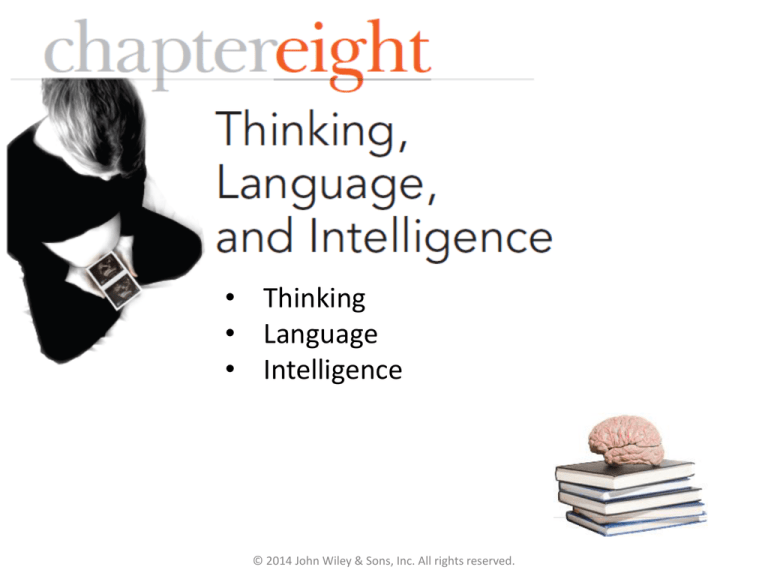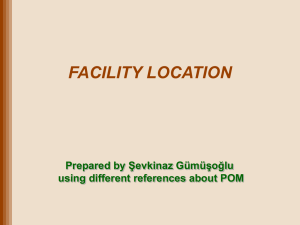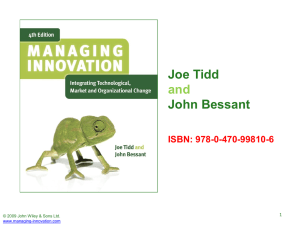
• Thinking
• Language
• Intelligence
© 2014 John Wiley & Sons, Inc. All rights reserved.
Things You’ll Learn in Chapter 8
Q1
Why might some medical treatments be judged
as more effective than they really are?
Q2
Can studying in a coffee shop improve your
creativity?
Q3
Can babies begin to learn language even before
they are born?
Q4
Do bigger brains indicate greater intelligence?
Q5
Does caregiving in the first years of life have a
lasting impact on brain size and development?
© 2014 John Wiley & Sons, Inc. All rights reserved.
Cognition
• Cognition = the mental activities involved in
acquiring, storing, retrieving, and using
knowledge
• Thinking is both localized and distributed
throughout the brain in networks of neurons
© 2014 John Wiley & Sons, Inc. All rights reserved.
Cognitive Building Blocks
• Imagine yourself at the beach. What do you
see? Smell? Hear? Feel?
• Mental image = the mental representation of
a previously stored sensory experience,
including visual, auditory, olfactory, tactile,
motor, or gustatory imagery
© 2014 John Wiley & Sons, Inc. All rights reserved.
Cognitive Building Blocks
• Concept = the mental representation of a group
or category
• Concepts developed through 3 building blocks
1. Prototype = the example that embodies the
“best” or most typical feature of a concept
Think of a
bird…..
© 2014 John Wiley & Sons, Inc. All rights reserved.
Cognitive Building Blocks
2. Artificial concept = a clearly defined concept
based on a set of logical rules, also known as a
formal concept
Did anyone think
of a penguin?
When something doesn’t fit the prototype, must
review artificial concept
© 2014 John Wiley & Sons, Inc. All rights reserved.
Cognitive Building Blocks
3. Hierarchies = subcategories within broader
concepts
• We learn basic-level before higher- and lowerorder
© 2014 John Wiley & Sons, Inc. All rights reserved.
Solving Problems
• Solving problems means moving from the given
state (problem) to a goal state (solution)
• Three steps:
1. Preparation – define goal, outline limits
2. Production – test possible options using
• Algorithms: logical, step-by-step procedure that will
always eventually solve the problem
• Heuristics: cognitive strategy or “rule of thumb” used as a
shortcut for problem solving; does not guarantee a
solution but does narrow down alternatives
3. Evaluation – determine if solution solves problem
© 2014 John Wiley & Sons, Inc. All rights reserved.
Solving Problems
• In what section of the grocery store can you
find sun-dried tomatoes?
• How could you find them?
– Algorithm – walk each isle until you find them
– Heuristic – guess which section they might be in
(Fresh produce? Canned vegetables?)
© 2014 John Wiley & Sons, Inc. All rights reserved.
Solving Problems
Other problem-solving techniques
• Insight: remember Kohler’s chimps from
Chapter 6 who stacked boxes to reach
bananas?
• Incubation period: mentally set the problem
aside for a while until the solution comes
without conscious thought.
© 2014 John Wiley & Sons, Inc. All rights reserved.
Barriers to Problem Solving
• Sometimes we struggle to solve
problems because:
• Mental set = a problem-solving
strategy that has worked in the past,
which we continue to use rather than
trying new strategies
• Functional fixedness = the inability to
think of an object functioning only in
its usual or customary way; adversely
affects problem solving and creativity
© 2014 John Wiley & Sons, Inc. All rights reserved.
Barriers to Problem Solving
• Confirmation Bias = the bias of preferring information
that confirms preexisting positions or beliefs, while
ignoring or discounting contradictory evidence
Q1
Why might some medical treatments be judged
as more effective than they really are?
Treatment outcomes in medical research
studies were judged to be more positive
when the evaluator knew what treatment
each patient received (not blind to
condition).
© 2014 John Wiley & Sons, Inc. All rights reserved.
How might this
affect a doctor’s
treatment
decisions?
• Ever heard of the
Sports Illustrated
“cover jinx”?
• That’s confirmation
bias!
© 2014 John Wiley & Sons, Inc. All rights reserved.
Barriers to Problem Solving
Improper use of heuristics
• Availability heuristic = a cognitive strategy
(shortcut) that involves making judgments
based on information that is readily available
in memory
• Representativeness heuristic = a cognitive
strategy (shortcut) that involves making
judgments based on how well an object or
event matches (represents) an existing
prototype in our minds
© 2014 John Wiley & Sons, Inc. All rights reserved.
Barriers to Problem Solving
• In sum, potential biases limit good judgment
and problem solving
• BUT availability and representativeness
heuristics are shortcuts that are more likely to
help us than hurt us by providing “inferences
that are fast, frugal, and accurate” (Todd &
Gigerenzer, 2000, p. 736)
© 2014 John Wiley & Sons, Inc. All rights reserved.
Creativity
• Creativity = the ability to produce original,
appropriate, and valued outcomes in a novel way
• Has three characteristics:
© 2014 John Wiley & Sons, Inc. All rights reserved.
Q2
Can studying in a coffee shop improve
your creativity?
• Three groups of participants experienced
varying levels of ambient noise (50 dB, 70 dB,
and 85 dB) while performing a test of
creativity.
• Who performed best? Those with moderate
background noise (70 dB).
© 2014 John Wiley & Sons, Inc. All rights reserved.
Creative Thinking
• Divergent thinking = an aspect of creativity
characterized by an ability to produce unusual
but appropriate alternatives from a single
starting point
© 2014 John Wiley & Sons, Inc. All rights reserved.
LANGUAGE
© 2014 John Wiley & Sons, Inc. All rights reserved.
Language
• Language = a form of communication using
sounds and symbols combined according to
specific rules
• To produce language, we use .…
– Phonemes – smallest basic unit of speech or sound,
which combine into ….
– Morphemes – smallest meaningful unit of language,
which combine into ….
– Grammar – the system of rules (syntax and semantics)
used to create language and communication
© 2014 John Wiley & Sons, Inc. All rights reserved.
Language
© 2014 John Wiley & Sons, Inc. All rights reserved.
Language and Thought
• Language doesn’t determine thought
– Whorf (1956) proposed the linguistic relativity
hypothesis, which suggested that the language
you speak determines how you reason, think, and
perceive the world (Inuits’ multiple words for
snow)
• Language does influence thought
– People who speak both Chinese and English say
the language they are using affects their sense of
self, influencing which cultural norms they adopt.
© 2014 John Wiley & Sons, Inc. All rights reserved.
Language Development
© 2014 John Wiley & Sons, Inc. All rights reserved.
Q3
Can babies begin to learn language even
before they are born?
• Newborns heard their native language or a different
language (English and Swedish) while sucking on a
pacifier hooked to a computer
• The babies who heard the foreign language sucked
more frequently, suggesting babies are more
interested in hearing new sounds … they had already
become accustomed to their native language while in
utero
© 2014 John Wiley & Sons, Inc. All rights reserved.
Language Development
Is language development nature or nurture?
• Language acquisition device (LAD) = according
to Noam Chomsky, an innate mechanism that
enables a child to analyze language and extract
the basic rules of grammar
– Children everywhere progress through the same
stages of language development, regardless of
language
• Nurturists argue that children learn language
through rewards, punishment, and imitation
© 2014 John Wiley & Sons, Inc. All rights reserved.
Can Animals Talk?
• Apes lack the anatomical structure needed to
vocalize like humans
• Gardner (1969): recognized chimp’s manual
dexterity and ability to imitate gestures
• The chimp Washoe learned
132 ASL signs and could
combine them into simple
sentences
• The gorilla Koko knew
1000 words
© 2014 John Wiley & Sons, Inc. All rights reserved.
Is it language?
• Nonhuman animal language is less complex,
less creative and has fewer rules than human
language.
– Some argue that animals don’t understand
language but are operantly conditioned to
respond
– Others claim that communication can occur but
animal ideas are severely limited
© 2014 John Wiley & Sons, Inc. All rights reserved.
INTELLIGENCE
© 2014 John Wiley & Sons, Inc. All rights reserved.
Intelligence
• Intelligence = the global capacity to think
rationally, act purposefully, profit from
experience, and deal effectively with the
environment
• Different cultures have different definitions of
intelligence that go beyond “book smarts”
© 2014 John Wiley & Sons, Inc. All rights reserved.
The Nature of Intelligence
Single factor
Multiple factors
• General intelligence (g) =
Spearman’s term for overall
general intellectual ability
– g underlies all
intellectual ability,
including reasoning and
problem solving
– Laid the foundation for
today’s standardized
intelligence tests
• Thurstone proposed seven
primary mental abilities:
– Verbal comprehension, word
fluency, numerical fluency,
spatial visualization,
associative memory,
perceptual speed, and
reasoning
• Guilford proposed 120
factors
© 2014 John Wiley & Sons, Inc. All rights reserved.
The Nature of Intelligence
• Cattell reanalyzed Thurstone’s data and
proposed two subtypes of g:
– Fluid intelligence (gf) = aspects of innate
intelligence, including reasoning abilities, memory,
and speed of information processing; relatively
independent of education and tends to decline as
people age
– Crystalized intelligence (gc) = knowledge and skills
gained through experience and education and the
ability to access that knowledge; intelligence that
tends to increase over the life span
© 2014 John Wiley & Sons, Inc. All rights reserved.
The Nature of Intelligence
• Gardner proposed theory of multiple intelligences:
people have different profiles of intelligence because
they are stronger in some areas than others and use
their intelligences differently
• Sternberg’s triarchic theory of successful intelligence
suggests three separate, learned aspects of
intelligence: analytic, creative, and practical
• Goleman popularized emotional intelligence (EI): the
ability to perceive, appraise, express, and regulate
emotions accurately and appropriately
© 2014 John Wiley & Sons, Inc. All rights reserved.
Measuring Intelligence
• Most IQ tests are designed to predict grades in
school
• Stanford-Binet Intelligence Scale: ages 3 to 16.
Includes copying geometric designs, identifying
similarities, and repeating number sequences
• Wechsler Adult Intelligence Scale: separate
scores for verbal and performance
© 2014 John Wiley & Sons, Inc. All rights reserved.
Measuring Intelligence
• Intelligence Quotient (IQ) = an index of intelligence
initially derived from standardized tests and by dividing
mental age by chronological age and then multiplying
by 100; now derived
by comparing
individual scores with
the scores of others
of the same age.
© 2014 John Wiley & Sons, Inc. All rights reserved.
Measuring Intelligence
• Intelligence tests must meet three basic
requirements:
1. Standardization = a set of uniform procedures
for treating each participant in a test, interview,
or experiment or for recording data
2. Reliability = the degree to which a test produces
similar scores each time it is used; stability or
consistency of the scores produced by an
instrument
3. Validity = the degree to which a test measures
what it is intended to measure
© 2014 John Wiley & Sons, Inc. All rights reserved.
Extremes in Intelligence
• Intellectually disabled (previously called mentally retarded):
applies to someone significantly below average in intellectual
functioning and has significant deficits in adaptive functioning
• Fewer than 3% of people; of this group, 85% have mild
intellectual disability; may score low on some areas and average
or gifted on others
• Savant syndrome = a condition in which a person with generally
limited mental abilities exhibits exceptional skill or brilliance in
some limited field
• Disabilities might be caused by genetic condition (Down
syndrome, fragile-X, PKU) or by the environment (prenatal
exposure to drugs, deprivation early in life, brain damage from
accidents)
© 2014 John Wiley & Sons, Inc. All rights reserved.
Extremes in Intelligence
• Gifted or high IQ are usually defined as the
top 1 to 2% of IQ scores.
• Terman (1921) followed 1500 kids with IQ of
140+ through childhood and adulthood
– Subjects became successful professionals at a
higher rate than others; tended to have
extraordinary motivation and support at school
and home
– Fared no better than the general population in
rates of alcohol abuse, divorce, and suicide.
© 2014 John Wiley & Sons, Inc. All rights reserved.
Nature, Nurture, and IQ
Recent neuroscience research shows:
• People with high IQ also respond faster on perceptual
judgment tasks (Bowling & Mackenzie, 1996)
• Intelligent brains work more efficiently than less
intelligent brains (Jung & Haier, 2007)
Can babies begin to learn language even before
Q3
they are born?
• Significant correlation between brain size and intelligence
• Einstein’s brain was no larger than normal: some areas were
smaller, but math and spatial info areas were 15% larger
© 2014 John Wiley & Sons, Inc. All rights reserved.
Nature, Nurture, and IQ
• Minnesota Study of Twins investigated
identical twins raised in different homes
© 2014 John Wiley & Sons, Inc. All rights reserved.
Nature, Nurture, and IQ
• Heredity equips people with innate intellectual
capacity; the environment significantly influences
whether a person will reach full potential
Q5
Does caregiving in the first years of life have a
lasting impact on brain size and development?
• Early malnutrition can stunt a
child’s physical brain
development, which affects
responsiveness to environment
and motivation to learning,
ultimately lowering IQ
© 2014 John Wiley & Sons, Inc. All rights reserved.
Differences Between vs Within Groups
• Historical group differences in
average IQ scores between black
and white people in US
• Differences between groups are
environmental (different soil)
not genetic (same seeds)
• Greatest differences appear
within groups: some blacks
score high, some score low;
some whites score high, some
score low
© 2014 John Wiley & Sons, Inc. All rights reserved.
Differences Between vs Within Groups
What else affects differences in IQ?
• Environmental factors can override genetic potential
• Traditional IQ tests may be culturally biased – they reflect white,
middle-class culture, which puts others at disadvantage if
knowledge, values, language don’t match test
• Intelligence is not a fixed trait. Flynn effect: IQ scores around the
world are increasing
• Dividing scores by race doesn’t take into account difficulty in
defining race and racial membership
• Stereotype threat = awareness of negative stereotype that affects
oneself and may lead to impairment in performance
© 2014 John Wiley & Sons, Inc. All rights reserved.
© 2014 John Wiley & Sons, Inc. All rights reserved.









